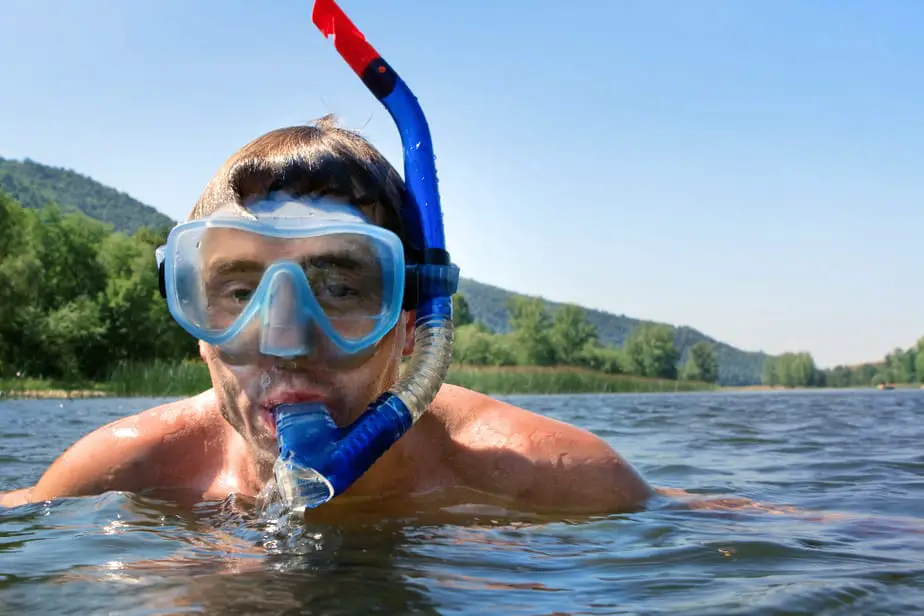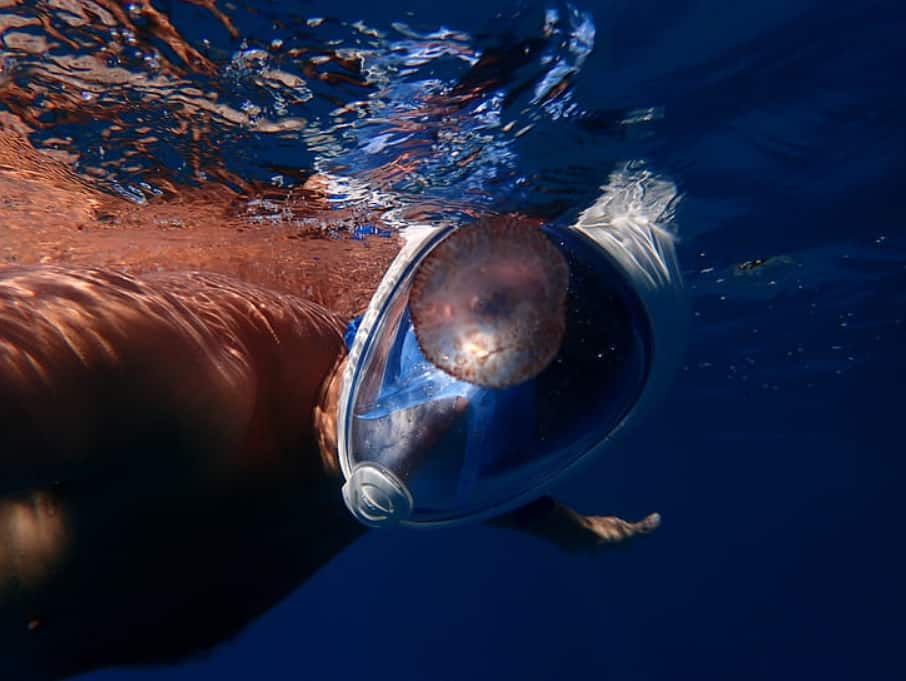In the last few years, full face snorkel masks have had a meteoric rise in popularity because of their convenience and usefulness. They feature an all-in-one design, combining both a mask and snorkel into one, and they cover the entire face. This allows wearers to breathe with either their mouth or nose without a mouthpiece. Full face masks offer many advantages over a traditional snorkel and mask setup, however it also has its downsides which you can read about here.
Having come out within the last decade, it is still quite new. What’s got people talking about it is that it’s the most recent major innovation in the snorkeling mask market. Just have a quick browse online and you’ll find many posts talking about it and how it compares to the traditional snorkel mask. Is the full face snorkel mask a gimmick, or is it something that will truly revolutionize snorkel mask design from now on?
In comparison, the classic snorkel mask has two components: the mask and the snorkel tube. The mask covers the eyes and nose, and the mouthpiece goes into the mouth. This basic design is sufficient for most people, however there is still a learning curve that beginners have to figure out. For a full face snorkel mask, beginners can simply put it on and start snorkeling, making it an attractive option for newbies.
There’s lots more to talk about in the fight between the full face snorkel vs. traditional snorkel mask. Read on to learn about the major benefits and downsides of each.
Traditional Snorkel and Mask Combo
The concept of a snorkel goes back a long time ago. When most people think of a snorkel, they imagine what snorkelers and scuba divers use to breathe at the surface while partially submerged. However, this idea was already in use over a thousand years ago, where evidence has been found of ancient divers using hollow reeds to get oxygen underwater. Furthermore, the Persians have made goggles from polished tortoise shells.
It’s surprising then, that there has been so little innovation for hundreds of years until 1920, when Maurice Fernez designed what is recognized as the modern set of waterproof goggles. From that point on, the design has been refined further and further until we now have the present snorkel mask with useful features like the silicone skirt, anti-fog and tempered glass lenses, and purge valve.
Furthermore, the snorkel design has also received major upgrades, with many classic wet snorkels being rapidly replaced by the dry snorkel. Dry and semi-dry snorkels come with a splash guard on the tube opening to reduce the amount of water that can enter. Additionally, an automatic tube sealing mechanism will prevent water from entering if the user submerges the tube or if an unexpected wave splashes onto it.
Snorkel masks have a standard size, but some masks have been designed specifically for small and narrow faces to fit women, teenagers, or small adults. Traditional snorkel masks are versatile, with many designed to be used for scuba diving and freediving. One can even use a low-profile snorkel mask for swimming, though goggles would be more compact.
Pros:
- Versatile, can be used for snorkeling, freediving, and scuba diving.
- Usable even in rough waters.
- Seals easily against the face.
- More sizes (for narrow faces, wide faces, kids, and standard size)
- More brands and models with innovative features due to their longer history.
- Easy to transition to breathing above water.
Cons:
- Has a higher learning curve.
- Need both a snorkel and snorkel mask.
- Mouthpiece can get dirty if not cleaned properly.

Full Face Snorkel Masks
The first full face snorkel mask was developed by Tribord, a French watersports company known for its innovation. It was first released in 2014, and its unique look – something like a cross between a space helmet and gas mask – caught the public’s attention. People wanted to know how well it worked and if it was worth using.
Let’s go over the main advantages of the full face snorkel mask. First, because the mask and snorkel are combined into one, there is no mouthpiece. This means that wearers could freely breathe with their mouth or nose instead of only with their mouth. This also protects against swallowing a mouthful of water. Next, the full face snorkel mask had a wider field of vision and an anti-fog design.
Since full face snorkel masks have appeared on the market, they have become immensely popular with casual snorkelers and sales were high. However, veteran snorkelers and divers have not adopted this mask since it cannot be used for scuba diving.
Furthermore, there are now numerous knock-off products which are not as reliable. The original product is from Tribord, and it is called the Easybreath.
Pros:
- It’s two products combined into one.
- Fog-free.
- Allow the wearer to breathe through either the mouth or nose.
- More hygienic since there is no mouthpiece to worry about.
- Wide field of vision (180 degrees)
- Often compatible with underwater cameras or GoPros.
Cons:
- Not as versatile since it cannot be used for scuba diving.
- Harder to seal on the face because of how large it is.
- More difficult to transition to normal breathing above water.
- Some say it is a tourist gimmick, though that depends on how well it works for you and if you care about other people’s elitist opinions.
- Controversial: May not vent out the CO2 properly, which can result in lack of oxygen and may have resulted in some deaths in Hawaii (more on this below).
Full Face Snorkel Vs. Traditional – Which to Choose?
If I had to pick between a full face snorkel mask vs traditional mask, I would still pick the traditional mask. Why? Well, I personally feel that the full face snorkel is more gimmicky than useful, and I have no need for it. However, let’s give it a fair chance here.
The full face snorkel mask does provide a wide lens for viewing the underwater sights while snorkeling. I like how there are many full face masks designed to work with a GoPro and other underwater cameras to take pictures of these amazing sights, which is incredible for preserving memories and bragging to family or friends.
With that said, I’m not a fan of how much harder it is to seal on the face and its lack of versatility. I’ll often dive down when I’m snorkeling, and the full face mask offers me no benefit there. Also when I’m swimming in the ocean I need a mask that seals tightly to prevent water leaks.
Potential Danger of Full Face Masks
There is speculation that some snorkeling emergencies that have resulted in deaths were caused by full face snorkel masks. Tests were done and found that carbon dioxide (CO2) exposure exceeded safety standards when breathing slowly, but were within limits for high breathing rates.
However, that is not enough evidence to conclusively lay the blame on full face snorkel masks. After all, the ocean is not exactly humans’ natural habitat, and there are inherent dangers involved in all water sport activity. The conclusion thus far is that more evidence and facts are required to determine the unusual deaths that occurred involving some snorkelers wearing a full face snorkel mask.
Furthermore, there have been thousands of positive reviews online with many snorkelers praising the wonderful snorkeling experience they had using a full face mask. We’d imagine it’s pretty safe overall, but it’s up to you if you want to believe the rumors or not. We recommend testing the mask in shallow waters or a pool before going into deeper waters.
Getting the Right Fit
Even if you had a preferred type of mask, the reality is that the only mask you should be using is the one that seals tightly and comfortably. If you have a narrow and small face, you may be out of luck when it comes to getting a full face snorkel mask. On the other hand, traditional snorkel masks have many sizing options and additional features.
With many reputable brands like Aqua Lung, Atomic, U.S. Divers, all of which offer low profile masks that are high-quality and provide a wide view, there’s lots to choose from if you are extremely picky about a mask that fits on you. These brands also offer XS versions of their full face masks so that your children can also try a full face mask if the regular snorkel and mask combo isn’t comfortable for them.
Furthermore, if you just want to take a break above water, with a snorkel and mask I simply remove my snorkel but keep my mask on, and this allows me to speak to people and breathe like normal. This basic feature that I take for granted is much harder to do with a full face snorkel mask. You’d have to remove the entire mask to breathe and talk normally. If you are wearing a full face mask, either learn how to do hand signals with your buddies or deal with having to remove the entire mask just to communicate.
Full Face Snorkel Mask vs Traditional – The Verdict
Now that you know a little bit about how the full face mask compares to the standard combo of snorkel and mask, it’s up to you to decide which you prefer. Over the decades, many advancements have been made to snorkeling, freediving, and scuba diving masks. It was only in the recent decade that a new engineering breakthrough happened, and full face masks flooded the market.
Given that the traditional snorkel mask and snorkel have their own uses in areas where the full face snorkel mask provides no benefits (such as diving), you don’t have to worry about if one type is going to replace the other. And if you’re a casual snorkeler that only plans on snorkeling, then perhaps a full face mask would be the ideal option.
You can get a panoramic view of the ocean while you float along the water’s surface in comfort. For more information on full face masks, check out our full face snorkel mask buying guide and review to see if it’s the right option for you.

